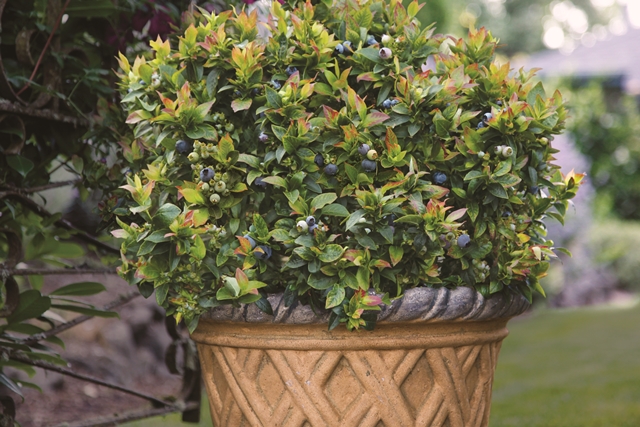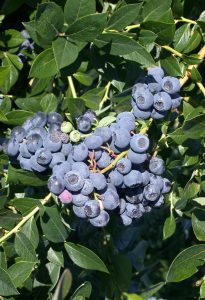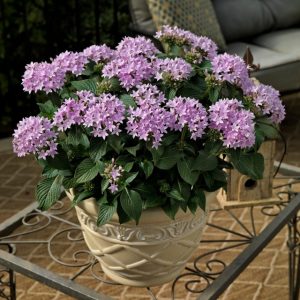By Ken Lain, the mountain gardener

On the Go Answer – Readers Digest-type Condensed Version of this Article
- July is National Blueberry Month
- Blueberry plants prefer growing in organic, acid rich soil and Watters Potting Soil
- Four foot spacing is ideal for blueberry bushes
- Plant in at least 6 hours of sun, and water every 3-5 days
- Feed at 6-8 week intervals with 7-4-4 All Purpose Food
- Blueberries prefer container gardens at least 14” in diameter
- Best mountain varieties are Jubilee, Patriot, and Sunshine blueberries
July is National Blueberry Month. It’s a great time to celebrate this super fruit! Plant blueberries in your garden, and you can pick fresh blueberries for all your summer entertaining. Nothing impresses friends, grandkids, and relatives more than the ability to pick fruit off the bush!
Benefits of Growing Blueberries
Blueberries have many advantages. First, let’s cover their pure beauty as a landscape shrub. The bell-shaped flowers bloom white in the spring, the blue-green foliage blessed with yummy berries in the summer, and gorgeous fall color. And, they’re SO easy to grow. Blueberries have a lot going for them!
Blueberries are a super fruit, rich in antioxidants, memory enhancing, aid in anti-aging, and improve vision. The bonus is that home-grown berries just taste better and save money!
Best Varieties for Mountain Gardens
New gardeners struggle with their first blueberry crop because there are a few secrets to growing a bush that produces an abundance of fruit. This unique plant loves peaty, acidic soils that are actively composting. This does not describe the native dirt we have in the mountains of Arizona!
Thus, the best results come when this proud landscape shrub is grown in a container or raised bed where much more potting soil and composted mulch can be added to the soil. This ensures a vibrant deep green foliage throughout the growing season.
Planting Blueberries and How to Grow Them
Most blueberries should be planted about 4 feet apart. The top of the root ball should be exposed to garden air and firmly backfilled with Watters Potting soil. This peat moss fertile soil ensures better drainage, reduced pH, and a massive harvest. This soil is meant to be planted directly into with no additives needed. Tamp down the earth around the roots to remove any air pockets.
Bigger is Better – Plant in a container at least 14″ in diameter for long-lasting blueberries that come back year-after-year.

Fertilizer – Feed with Watters, 7-4-4 “All Purpose Plant Food” at six to eight-week intervals. The additional sulfur in this organic food ensures the most substantial berry formation and better plant color.
Water – Best to water at 3-5 day intervals for consistent hydration. It is highly recommended to place a saucer under the container to increase the soil’s water retention.
Sunny Locations – Plants can be placed in full sun to part shade, but the ideal location would be an eastern exposure. Directly under a tree also works well. Early morning sun followed by midday shade followed by afternoon sun is well-suited for blueberries.
Hardiest Mountain Varieties
Jubilee Blueberry – Perfect for warmer climates and higher elevations. Abundant crops of sky-blue fruit are extra sweet as they mature from late summer through fall. The dusted blue-green foliage remains evergreen in mild winters and can have an orange cast when exposed to full sun locations.

Patriot Blueberry – Prized for its early crop of substantial sweet berries with a profusion of delicately tinged flowers. This massive bush can grow to 10 feet tall but not in the mountains of Arizona, where 5-6 feet can be expected from this most hearty of blueberry bushes. The multi-stemmed form and brilliant fall colors of yellow, bronze, and red make it a prize for those gardens needing some fall landscape color.
Sunshine Blueberry – If you want a beautiful, vigorous bush that produces waves of berries, this is the blueberry for you. Hot pink flowers fade to white that yield abundant crops of large tangy blueberries. This semi-dwarf shrub is well suited for container gardens overflowing with companion plant petunias for a stunning sight. This is one of the few bushes that are self-pollinating. When planted with another variety of blueberry in the same backyard, it will double production.

July Companion Plant is Penta. Butterflies cannot resist the sweet nectar produced by the large clusters of starry flowers on super sturdy stems. This pretty little flower loves heat and wind, requiring minimal care to keep the flowers coming. The large clusters of vibrant, star-shaped flowers are a stunning choice for vivid color in pots and raised beds. A superb flower that outperforms others as long as it’s hot.
Free Gardening Classes – Held outdoors at Watters Garden Center, social-distancing is assured with lots of plants between each student. We upgraded our P.A. system with a direct link to our live Facebook stream. Classes are held every Saturday from 9:30 to 10:30 am. Here is the July lineup:
July 4th – Closed to celebrate our Independence
July 11 – Plant Better Berries and Grapes
July 18 – Avoid these Common Pests at All Costs
Until next issue, I’ll be helping locals choose the juiciest blueberry bushes for their gardens from Watters Garden Center. Ken Lain can be found throughout the week at Watters Garden Center, 1815 W. Iron Springs Rd in Prescott, or contacted through his web site at WattersGardenCenter.com or FB.com/WattersGardenCenter

